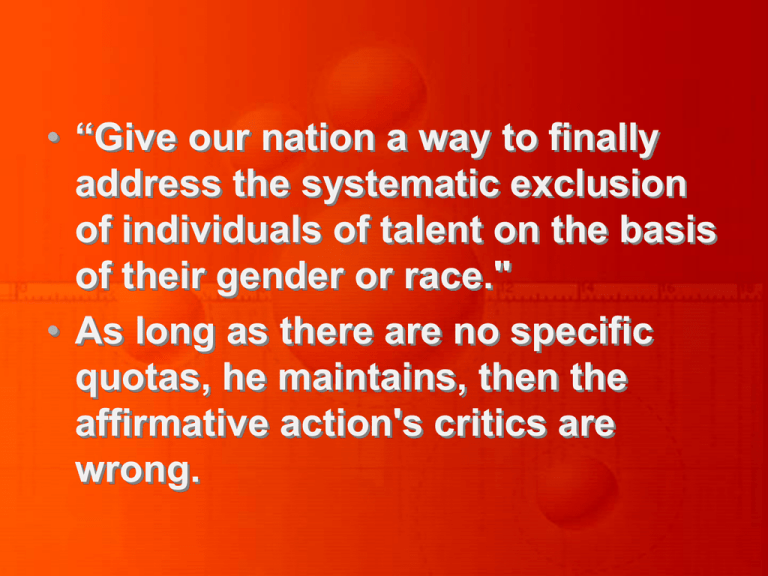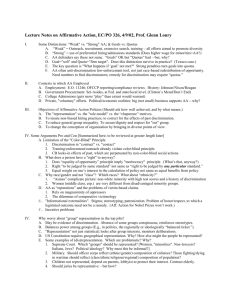Slide 1 - Vutube.edu.pk
advertisement

• “Give our nation a way to finally address the systematic exclusion of individuals of talent on the basis of their gender or race." • As long as there are no specific quotas, he maintains, then the affirmative action's critics are wrong. Report of Glass ceiling comission • Largest USA commission sponsored by republican members in congress, said: 1. In nations largest companies only 0.6% African Americans, 0.4% of Hispanic Americans, 0.3% by Asian Americans are on senior management positions, women hold 3-5% of these position. • White men make up 43% of our work force, but they hold 90% of these jobs. Report of Chicago Federal Reserve Bank • Rejection rates for home loan applications submitted by blacks are double in comparison with white men having the same qualifications. • The Hispanic applicants are more than one and half times rejected in the same way. Bill Clinton & His Four Points • Federal agencies apply the four standards of fairness: 1. No quotas. 2. No illegal discrimination of any kind. 3. No preference for the people who are not qualified for the jobs. 4. As soon as as a program is succeeded, it must be retired. • Clinton calls for the U.S. to preserve its affirmative action programs “As long as there are no specific quotas, he maintains, then the affirmative action's critics are wrong”. Former California Governor Pete Wilson • He argues that it is unfair to award jobs based on any criteria other than merit. • \He sees affirmative action as preferential treatment, "special privileges" for a selected minority–in effect, a type of reverse discrimination. Reverse discrimination • A form of discrimination against male non-minority members due to the effects of affirmative action and racial quotas. Purpose of Discussing this topic • Because discrimination based on gender and race have been around for so long in business, its consequences in this area have been substantial and persistent. • We have to explore nature of discrimination, discusses the ethical aspects of such behavior, and conclude by considering affirmative action programs in particular. Job Discrimination: Its Nature • Though more women and minorities are entering formerly white maledominated jobs, they still face discrimination. • The experiment conducted by ABC shows that women and minorities were systematically given less consideration in hiring. • They received fewer job offers and less desirable jobs than white males. • Other research suggests that blacks and Hispanics were offered jobs 50% fewer times than white males. Discrimination • Discrimination in its root meaning is not at all wrong. • It simply refers to the act of distinguishing one object from another. • However, in modern usage, the term refers to "wrongful discrimination," or distinguishing among people on the basis of prejudice instead of individual merit. Discrimination in employment • Discrimination in employment involves three basic elements: 1. It must be a decision not based on individual merit. 2. The decision must derive from racial or sexual prejudice. 3. The decision must have a harmful impact on the interest of employees. Discriminatory acts • • Discriminatory acts themselves can be categorized according to the extent to which they are intentional and institutionalized. An act may be part of the isolated behavior of a single individual who: 1. Intentionally discriminates based on personal prejudice. Discriminatory acts 2. An act may be part of the routine, institutionalized behavior of a group. 3. The act must intentionally discriminate out of personal prejudice. 4. An act may be part of the isolated behavior of a single individual who un-intentionally discriminates because he or she uncritically adopts the practices and stereotypes of his or her society. Group Discriminates • An act may be part of the systematic routine of a group that un-intentionally discriminates because group members un-critically incorporate the discriminatory practices of society. • Whereas in the early 1960s, discrimination was generally seen an intentional and individual. • By the 1970s, a shift had occurred to emphasize the effects of un-intentional forms of discrimination. • A group would be guilty of discrimination, if minority group representation were not proportionate to the minority group's local availability. Discrimination • Subsequently, people came to criticize this view. • They argued that discrimination was the act of individuals, and that individual minorities and women were its victims. • The problem with this criticism is that, it is often difficult to know whether a specific individual was discriminated against. Discrimination • The only way of telling whether a process is fair or discriminatory is to see what happens to minorities as a group. • American society has gone back and forth on this issue ever since. • Many even believe that though businesses in the U.S. used to be discriminatory, they are no longer so. Discrimination: Its Extent • An indication of discrimination exists when a disproportionate number of a certain group's members hold less desirable positions despite their preferences and abilities. • We can make three types of comparisons to provide evidence of this type: Three types of comparisons 1. Comparisons of average benefits given to various groups. 2. Comparisons of the proportion of a group found in the lowest levels of the institution. 3. Comparisons of the proportion of a group found in the most advantageous positions in the institution.






